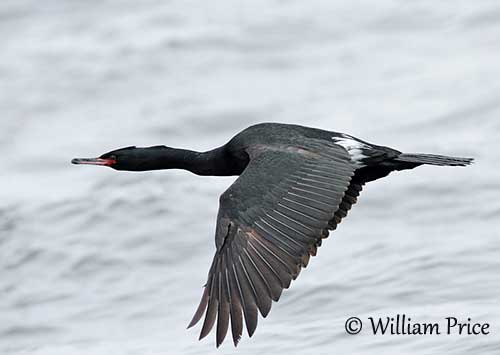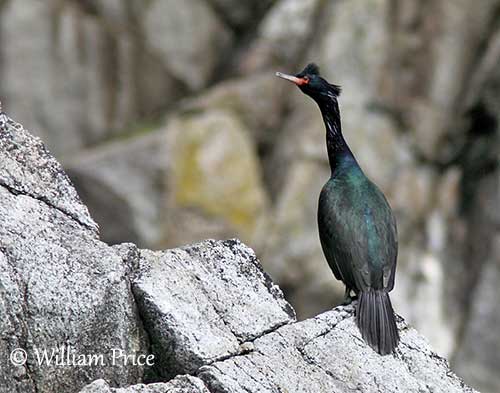
Fr: Cormoran pélagique
Ang: Pelagic Cormorant
All: Meerscharbe
Esp: Cormorán Pelágico
Ita: Cormorano pelagico
Nd: Pelagische Aalscholver
Sd: pelagskarv
Photographers:
Tom Grey
Tom Grey's Bird Pictures & Tom Grey's Bird Pictures 2
Patrick Ingremeau
TAMANDUA
William Price
PBase-tereksandpiper & Flickr William Price
Text by Nicole Bouglouan
Sources:
HANDBOOK OF THE BIRDS OF THE WORLD vol 1 by Josep del Hoyo-Andrew Elliot-Jordi Sargatal - Lynx Edicions - ISBN: 8487334105
All About Birds (Cornell Lab of Ornithology)
Bird Web (Seattle Audubon Society)
What Bird-The ultimate Bird Guide (Mitchell Waite)
Wikipedia, the free encyclopaedia
Alaska Seabird Information Series
COASST – Coastal Observation and Seabird Survey Team
Biodiversity of the Central Coast
Pelagic Cormorant
Phalacrocorax pelagicus
Suliformes Order – Phalacrocoracidae Family
INTRODUCTION:
The Pelagic Cormorant is usually less gregarious than other cormorant species. It feeds solitary and its nesting colonies are smaller. It is a small member of the family Phalacrocoracidae, and the smallest of the North American cormorants.
It breeds on both coasts of North Pacific (NE Siberia and SW Alaska), and winters S to Japan and E China, and Baja California. It nests on cliff ledges and hollows on steep rock faces, sometimes with other cormorant species.
The name of the Pelagic Cormorant is misleading, because this species frequents nearshore waters year-round.
This species is threatened by oil pollution and interaction of nearshore fisheries, and disturbance at nesting sites with the increase of recreational activities. But currently, the population is suggested to be stable.

DESCRIPTION OF THE BIRD:
Biometrics:
Length: 63-76 cm
Wingspan: 100 cm
Weight: 1475-2435 g
The Pelagic Cormorant is very similar to the Red-faced Cormorant in appearance.
The plumage is black with purplish and greenish highlights. During the breeding season, the purple-glossed nape and upperneck show scattered white filoplumes, also visible on back and rump. We can see a conspicuous white patch extending from rump sides to rear flanks. Mantle and scapulars show olivaceous to golden iridescence. On the wings, the flight-feathers are duller blackish with some gloss on outer webs of secondaries. The underwing and the tail are dull blackish.
The breeding adult has erect crest on crown and nape area, formed by upcurved, longer, black feathers. It develops a patch of red or orange skin around the eyes and the bill base, and on the gular pouch. This area is brightly coloured during the displays. The eyes are green. The bill is horn-coloured and grey, sometimes pinkish-orange with dark culmen and tip. Legs and webbed feet are blackish-grey.
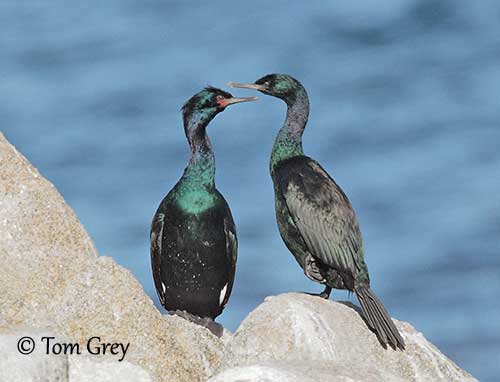
Breeding plumage on the left
Non-breeding plumage on the right
In the non-breeding adult, the crest is reduced or absent, or with only some long feathers. The plumage is still glossy but duller overall. The bill becomes grey to blackish.
Both adults have similar plumage, but the female is slightly smaller than male.
The juvenile is black overall with dark brown eyes. It is much duller than adults.

SUBSPECIES AND RANGE:
The Pelagic Cormorant has two subspecies.
P.p. pelagicus (described above), breeds in N Pacific coasts, from NE Siberia (Chukotskiy Peninsula) S to Kuril Islands, N Japan and NE China, and E through Commander Islands, Aleutian Islands and Alaska to W Canada (Queen Charlotte Islands). The W populations winter S to Japan and E China.
P.p. resplendens (displayed) occurs in SW Canada (British Columbia) to NW Mexico (Baja California). This race is slightly smaller than nominate.
HABITAT:
The Pelagic Cormorant is found on coasts and in bays where it feeds. When at sea, it usually remains close to the shore, but it may sometimes go out to sea. It frequents rocky bays, and especially deep waters close to the base of cliffs.
It nests both on islands and mainland coasts, often in inaccessible sites, narrow ledges on cliffs or steep slopes.
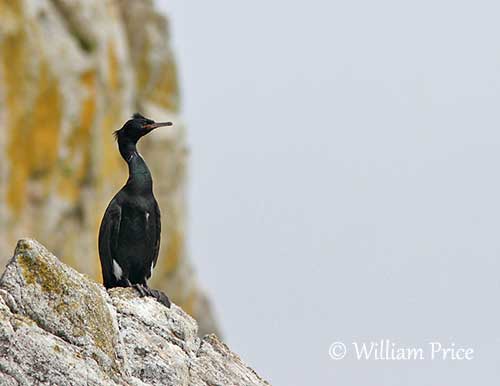
CALLS AND SONGS: SOUNDS BY XENO-CANTO
The Pelagic Cormorant produces groaning and hissing calls around the colonies. Perched birds may give low-pitched moan and clicking sounds. The male produces a high-pitched trumpeting honk when arriving at nest or flying off.
BEHAVIOUR IN THE WILD:
The Pelagic Cormorant feeds on fish, crustaceans and other invertebrates on the bottom. Fish includes sculpin, herrings, greenlings and sand lances. It also consumes crabs and shrimps, marine worms, amphipods and algae.
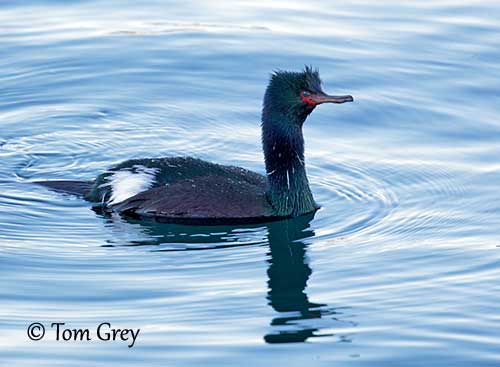
It usually forages in inshore waters. It dives easily, performing near-surface dives between one and six metres deep, and benthic dives at 28-33 metres deep. It swims underwater, propelled by its large webbed feet, while the wings are tucked tightly to the body sides. The thick, muscular legs are powerful and the four toes are wide open to maximize the webbed area for steering. After fishing, it perches in dry area and spreads its wings to dry them.
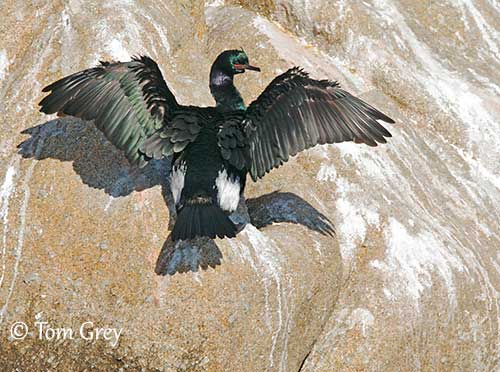
During the breeding season, the Pelagic Cormorant male tries to attract females by fluttering the black wings, in order to create a strong contrast with the conspicuous white rump patches. The strongly iridescent plumage, the thick crest and the red skin of the face are enhanced by adapted postures. The bill is pointed upwards and the tail is lowered, while the wings are raised and lowered. The displays take place at nest-site.
The Pelagic Cormorant is often sedentary, but some populations perform short post breeding dispersal. The northernmost populations of NE Siberia and NW Alaska are migratory and reach SE Alaska and N British Columbia. It is a wintering visitor to Korea and China, and further S to Baja California.
The flight is graceful and direct, with rapid wingbeats.
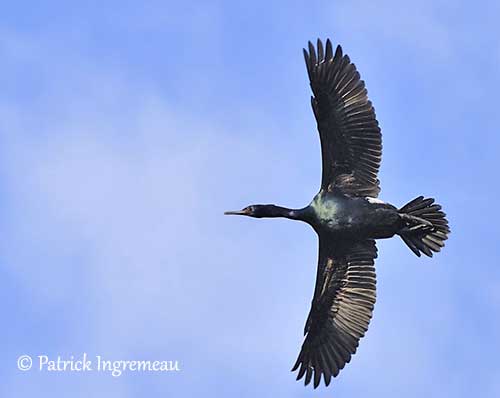
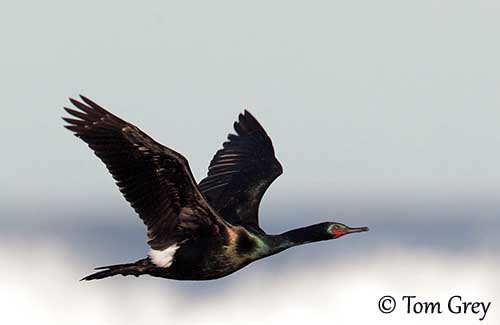
REPRODUCTION OF THIS SPECIES:
The laying occurs between May and July. The Pelagic Cormorant nests in small colonies and as isolated pairs. It nests on inaccessible sites such as narrow ledges or hollows on tall, steep rocks and cliffs. The nest is made with sticks, algae, grass, moss and debris, cemented together with guano. The nest is reused in several following years. Both adults share the nest-building, and add new material every year.
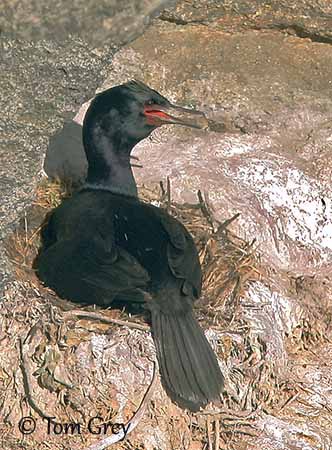
The female lays 3-5 bluish-white eggs, becoming stained in the nest. Both adults incubate during one month. At hatching, the chicks are naked, but they have sooty down very soon. They are fed by their parents, and perform short flights at 35-40 days old. They leave the nest between 45 and 55 days after hatching. They still depend on parents for food for a few weeks after leaving the nest.
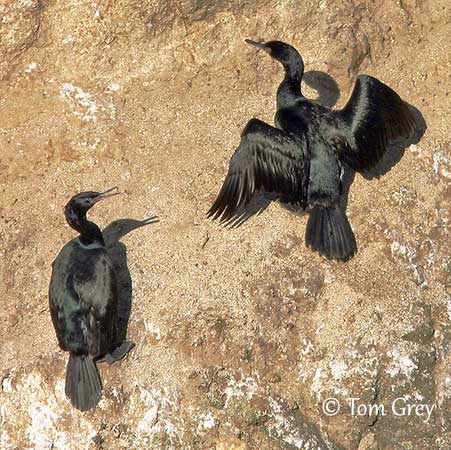
PROTECTION / THREATS / STATUS:
The Pelagic Cormorant is vulnerable to oil pollution and other contaminants. They may drown in gill-nets around fisheries close to their feeding areas. They are affected by disturbance at nesting sites through increasing recreational activities.
The population size is currently unknown, but the overall trend is decreasing, although some populations are probably stable.
The Pelagic Cormorant is currently evaluated as Least Concern.
